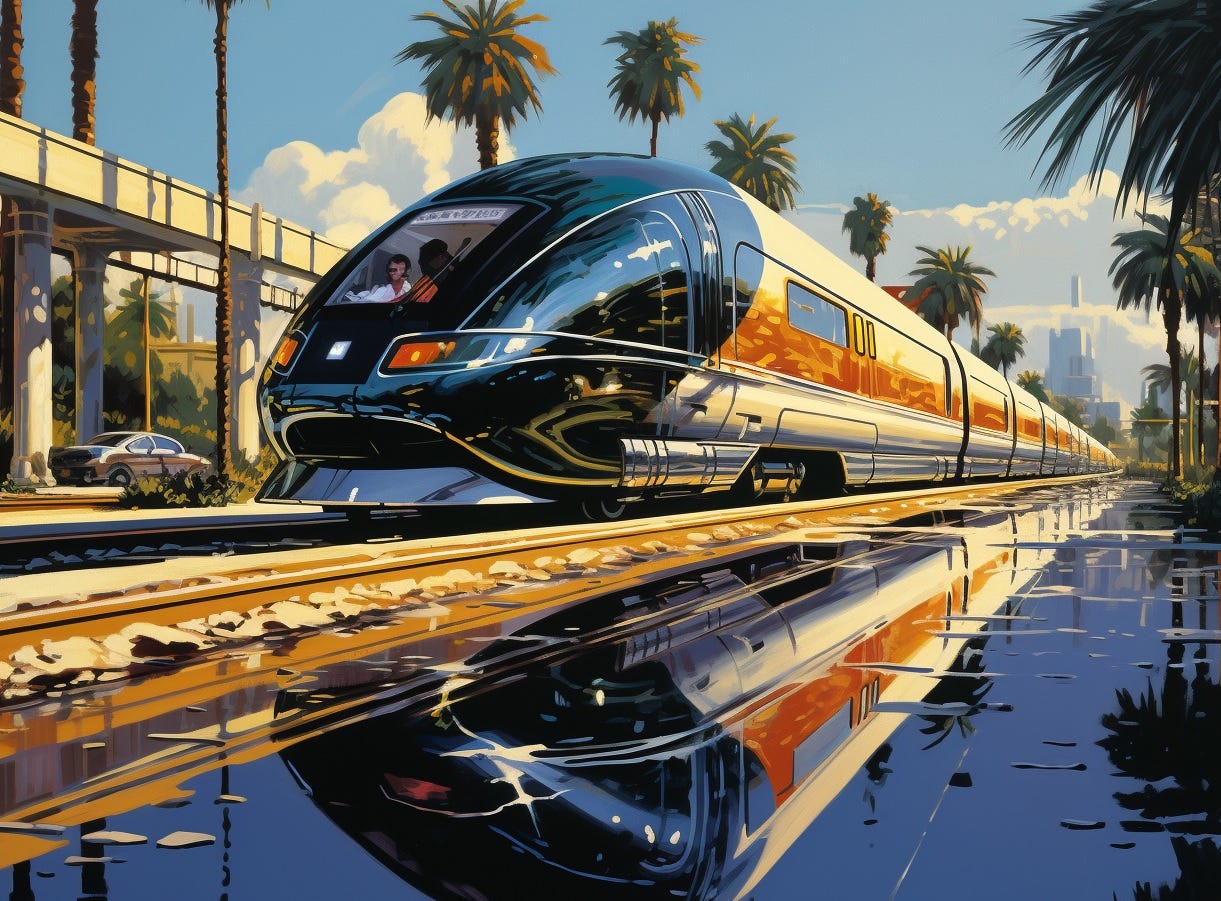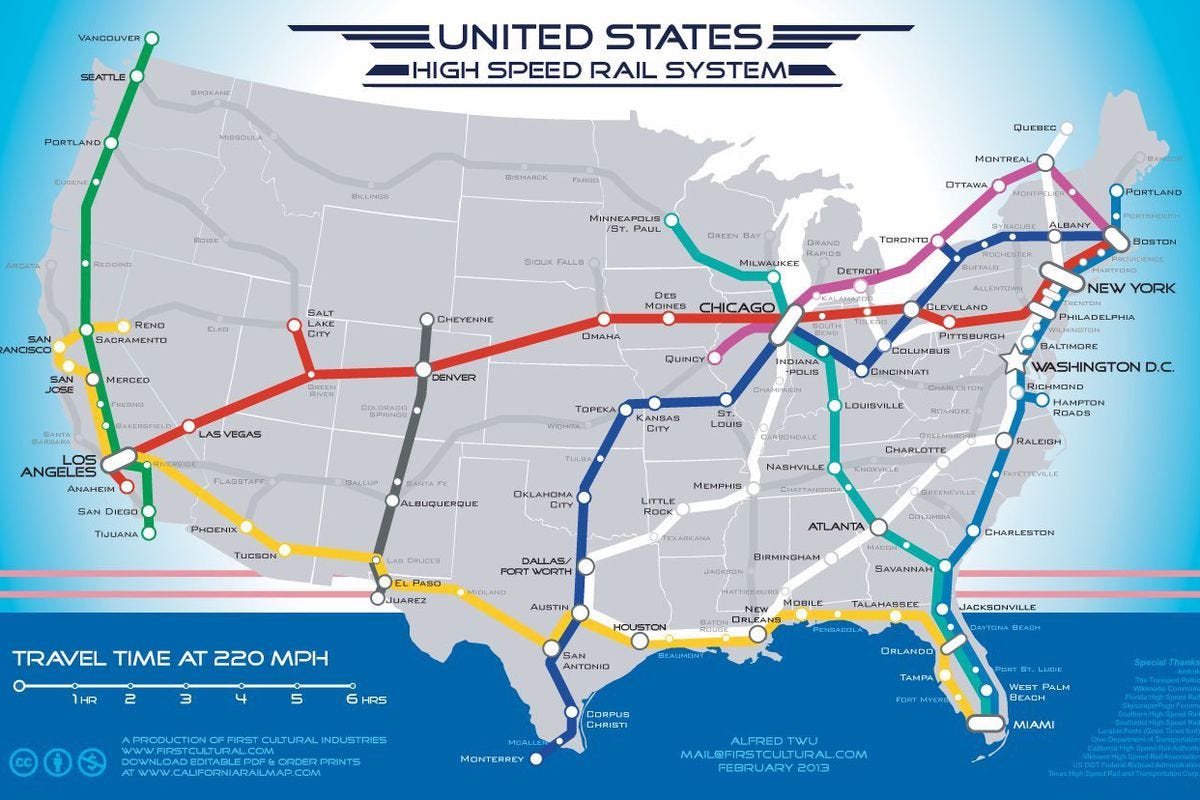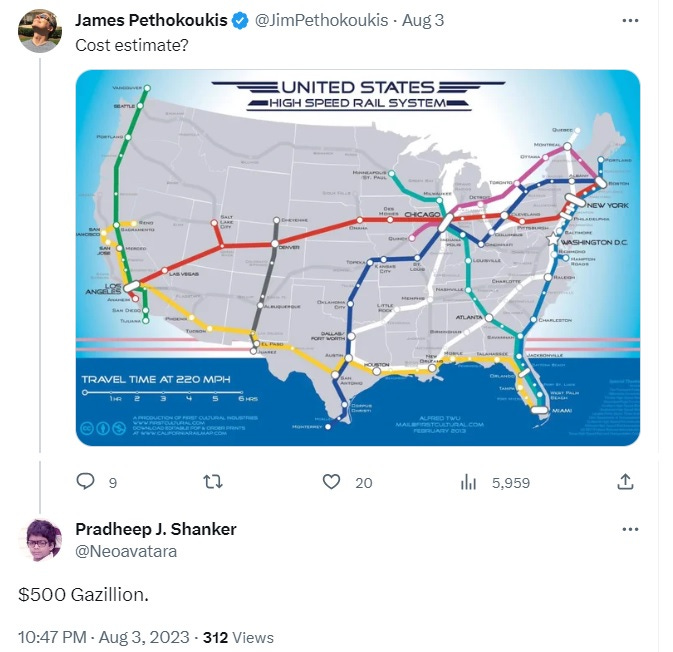Super Superconductors Aren’t Needed for High-Speed Rail in America
August 09, 2023
Quote of the Issue
“Scully, let me tell you, you haven’t seen America till you’ve seen it from a train.” – Fox Mulder, The X-Files
Room Temperature Superconductor Update:
The Essay

🚅 Super superconductors aren’t needed for high-speed rail in America
As the above forecasts show, the replication news on room temperature and pressure superconductors isn’t so hot. Looks like we’re going to have to hit pause (but not cancel) on our Up Wing dreams of warp-speed progress toward nuclear fusion, undersea cities, and space colonies. The same goes for coast-to-coast, supersonic maglev trains.
But as to that last point, high-speed rail enthusiasts and some “time to build” types will surely continue to think that the following, more than decade-old, aspirational graphic accurately suggests an America that someday could be and definitely should be:

I’m not sure who would want to whoosh from Portland, Maine, to Portland, Oregon at, say, 200 to 300 miles per hour rather than fly — let’s set aside the possibility of hyperloop technology — but this North American, coast-to-coast system would make that possible. I would imagine, however, that Washington to New York or LA to Vegas would be a more common trip. That said, this ambitious transportation vision keeps popping up on social media. “For members of the young online left, the high-speed rail map has become a ubiquitous fixture of politics Twitter,” wrote Vox reporter Gabby Birenbaum back in 2021.
I’m more of a train than a plane guy myself, so I get the appeal of never having to deal with air turbulence again or spending lots of time hanging out at the airport. But a basic question: How much would it cost to build the “American High Speed Rail System” (assuming you didn’t care that many of the routes depicted probably don’t make much economic sense unless they were supersonic hyperloops)?
When I asked that exact question on Twitter, I expected plenty of snark — and that’s just what I got:

Of course, the above is just one HSR concept. President Obama originally proposed an 8,600-mile high-speed rail system in 2009. His plan later expanded to about 12,000 miles of routes across the country. In 2020, the U.S. High Speed Rail Association proposed a 17,000-mile true high-speed rail network reaching 43 states, plus 11,000 miles of moderate-speed rail. But with over 22,000 miles of routes, China already has about twice as much high-speed rail as the rest of the world. For the U.S. to lead the world — as US Transportation Secretary Pete Buttigieg wants — it would need to build even more mileage than currently proposed.
A less humorous but (barely, perhaps) more realistic cost estimate of those plans can be found in the 2021 analysis by Randal O’Toole for the Cato Institute, using the California high-speed rail project as a baseline:
California has spent an average of more than $100 million per route‐mile building 220 mph track on flat land. The latest estimates project that the entire 520‐mile route will cost $100 billion, of which $20 billion is for 120 miles of flat land and $80 billion is for 400 miles of hilly or mountainous territory. That works out to $200 million a mile for hilly areas. At these costs, Obama’s original high‐speed rail plan would require well over $1 trillion, while the USHSR’s plan would need well over $3 trillion. Building a system longer than China’s would cost at least $4 trillion.
An update of those numbers would likely show even higher cost estimates. In May, the California High-Speed Rail Authority released updated cost estimates, forecasting it will cost as much as $128 billion, up from $100 billion a few years ago, $40 billion in 2008, and $25 billion when the concept was first proposed back in 1999. (And the current goal is to merely have a starter segment between Bakersfield and Merced operational between 2030 and 2033.) As CNBC reports, “Inflation and higher construction costs have contributed to the high price tag.”
California can’t do much about the price surge of recent years, but construction costs are another matter — as is the fact that after 15 years of effort, not a single mile of track has been laid. A 2020 New York Times piece highlighted myriad reasons for the price escalation and delay:
- Politics. Political interests like unions, environmentalists, and legislators pushed for different routes, stations, and mitigations, adding complexity, delays, and expenses. For example: Starting construction in the Central Valley rather than urban areas was driven by political pressure to secure funding and appeal to rural voters.
- Incompetence. California lacked expertise and oversight to manage the complex project, relying heavily on consultants and contractors with unclear roles. The authority failed to adequately plan, design, and coordinate the project, causing frequent changes, errors, and disputes. Land and utility costs, for instance, were underestimated, causing significant overruns.
- Barriers. The project also faced legal challenges from stakeholders — property owners, farmers, and local governments — as well as numerous regulations on safety, environment, and labor, adding time and cost. Multiple agencies had to approve permits, further delaying the project.
Delays due to regulatory and permitting bottlenecks are hardly just a California thing, of course. And Washington is starting to figure this out. From CNBC:
Some are calling to reform the National Environmental Policy Act to expedite infrastructure projects that would have a positive impact on the environment.
“When the National Environmental Policy Act makes us think really hard about building a 14-lane highway, that’s a good thing because 14-lane highways are terrible for the environment,” said Rep. Seth Moulton, D-Mass. “But when it makes high-speed rail so difficult to build in America, something that’s so fundamentally good for the environment, then we’ve got a problem. And that’s where we need reform.”
California’s troubles, along with the broader criticism that air travel is a better transportation option for a large and relatively sparsely populated country with most of its major cities far apart from each other, may suggest writing off any high-speed rail expansion. As my AEI colleague Richard Geddes told me back in 2021:
Back when the Transcontinental Railroad was built, it was pretty much the only way of getting across the country. But now, there’s a whole bunch of competing modes. You can drive, take an airplane and shuttle, or take Amtrak. So the issue is: How does high-speed passenger rail fit in with the other modes?
It’s very much dependent on the distance and density of people. And there are some areas that make no sense for high-speed rail. But I believe the Northeast Corridor — down to Richmond and up to Washington, Philadelphia, New York, and Boston — is an ideal route. You have the old urban core with those centers, and you have the density of population in that corridor.
Houston-Dallas may be another case. Certain routes in Florida make sense. But San Francisco to LA, for instance, is already served by a number of different air shuttles, and that’s a pretty long distance for a passenger rail to travel. And so as that distance between the origin and the destination grows, air travel starts to dominate passenger trains for benefit-cost reasons.
Yet HSR is slowly creeping forward. Among the current projects:
- Brightline Florida: The privately owned company is scheduled to start connecting Miami to Orlando at 125 mph this summer. It also plans to expand its network to Tampa in the future.
- Amtrak’s next-generation Acela trains: The new trains, built by Alstom, will run at speeds of up to 160 mph on the Northeast Corridor between Boston, New York, and Washington. They are expected to enter service, eventually, when key segments of the Northeast Corridor – including aging bridges and tunnels around New York and Baltimore — are upgraded with new federal funds.
- Brightline West: The project, formerly known as XpressWest, aims to build a $10 billion high-speed rail link between Los Angeles and Las Vegas by 2027 and break ground this year. The trains would run at speeds over 185 mph on dedicated tracks.
- Texas Central Railroad: The private company is developing a high-speed rail line between Dallas and Houston, using Japanese Shinkansen technology. The trains will run at speeds up to 205 mph and the project is expected to be completed by 2026.
We may see a mix of projects where they a) make economic sense and b) are financed entirely or largely with private funds. (The Brightline West project, for instance, has applied for a $4 billion federal grant.) Trains fans shouldn’t let some vision of a continent-spanning, interconnected system where every major city gets a stop distract them from what is possible and what is actually happening.

In the above map, from transit expert Alon Levy, the red lines are high-speed rail, ranging from 150 to 200 miles per hour, depending on population density and geography. Note that not all the rail lines are connected. Nor is every large population center connected. Levy:
The median distance of a domestic American air trip is well above the point beyond which HSR stops being competitive with air travel. Counting only city pairs at a plausible HSR range of around 4-5 hours, maybe a bit more for New York-Atlanta, my estimate is that about 20-25% of domestic US air trips can be substituted by rail. … However, the fact that people will continue flying until vactrains are invented does not make HSR useless or unnecessary. After all, people fly within Europe all the time, even within individual countries like France. Not only do people fly within Japan, but also the country furnishes two of the world’s top air routes in Tokyo-Sapporo and Tokyo-Fukuoka. As an alternative at its optimum range of under about 1,000 km, HSR remains a solid mode of travel.
We shouldn’t let the perfect be the enemy of the good, and we shouldn’t let personal or aesthetic preferences be the foe of the practical.
Micro Reads
▶ Post-pandemic productivity improves – Michael Feroli, JPMorgan Economics |
Looking beyond the next few quarters, the story could follow several different plotlines. One encouraging possibility is the scope for artificial intelligence to supplement the productivity of knowledge workers. The investment prerequisite for the IT boom of the ‘90s was business investment in information processing equipment. In any prospective AI boom the investment prerequisite will likely be investment in software. So far, the prospects in this cycle look promising. More generally, private investment in intellectual property has not suffered the hangovers that occurred after each of the prior two recessions. Productivity forecasts are subject to more than the usual uncertainty that pertains to economic forecasts. However, if we are to see an AI-driven resurgence in productivity, the business sector is already doing its part.
▶ Welcome to the Age of ‘Foomscrolling’ – Ross Andersen, The Atlantic |
▶ Elon Musk Says We Need Way More Electricity. Is He Right? – Nathaniel Taplin, WSJ |
▶ After 25 years of hype, embryonic stem cells are still waiting for their moment – Antonio Regalado, MIT Tech Review |
▶ AI Is Building Highly Effective Antibodies That Humans Can’t Even Imagine – Amit Katwala, Wired |
▶ Meta disbands protein-folding team in shift towards commercial AI – Cristina Criddle in London and Hannah Murphy, FT |
▶ Amazon’s Robot Workers to Help Run Australia’s Largest Warehouse – Amy Bainbridge, Bloomberg |
▶ Crypto’s Next Craze? Orbs That Scan Your Eyeballs. – David-Yaffe Bellany |
▶ NASA weighs changes to Artemis 3 if key elements are delayed – Jeff Foust, Space News |
▶ GPT-4 Can’t Reason – Konstantine Arkoudas, Arxiv |
▶ Loquacity and Visible Emotion: ChatGPT as a Policy Advisor – Claudia Biancotti and Carolina Camassa, Bank of Italy |
▶ The Crowdless Future? How Generative AI Is Shaping the Future of Human Crowdsourcing – Leonard Boussioux, Jacqueline N. Lane, Miaomiao Zhang, Vladimir Jacimovic, Karim R. Lakhani, SSRN |
▶ How AI is helping airlines mitigate the climate impact of contrails – Carl Elkin and Dinesh Sanekommu, Google |
▶ Pope Warns Artificial Intelligence Could ‘Fuel Conflicts And Antagonism’ – Molly Bohannon, Forbes |
▶ China needs to boost productivity given ‘demographic challenge,’ says economist – Sumathi Bala, CNBC |
▶ The U.S. Government Will Pay to Remove Carbon From Atmosphere – Robinson Meyer, Heatmap |
▶ Fertility Collapse Demands New Cultures – Malcolm and Simone Collins, Palladiu |
▶ Why a “room-temperature superconductor” would be a huge deal – Dylan Matthews, Vox |
Sign up for the Ledger
Weekly analysis from AEI’s Economic Policy Studies scholars



